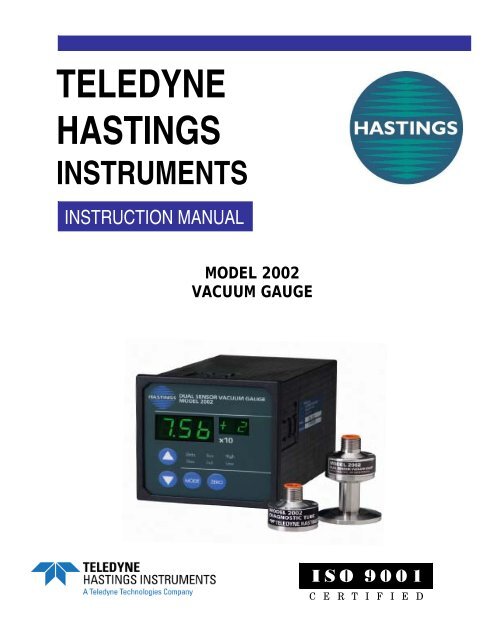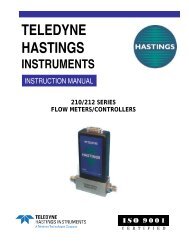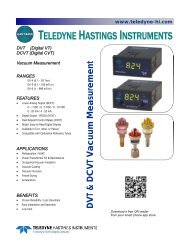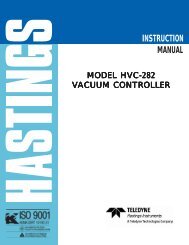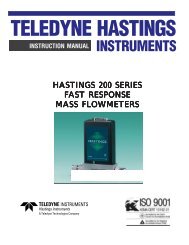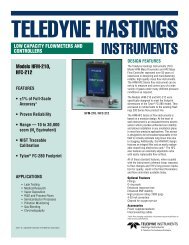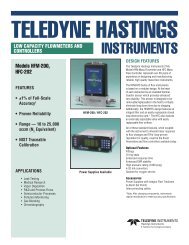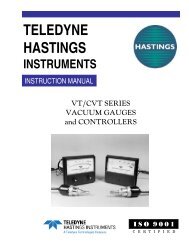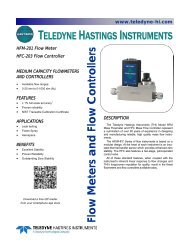HPM-2002 - Teledyne Hastings Instruments
HPM-2002 - Teledyne Hastings Instruments
HPM-2002 - Teledyne Hastings Instruments
You also want an ePaper? Increase the reach of your titles
YUMPU automatically turns print PDFs into web optimized ePapers that Google loves.
Table of Contents1. GENERAL INFORMATION......................................................................................................................................... 41.1. FEATURES................................................................................................................................................................. 41.2. MODEL <strong>2002</strong> SENSORS.............................................................................................................................................. 41.3. MODEL <strong>2002</strong> CONTROL UNIT ................................................................................................................................... 41.4. SPECIFICATIONS........................................................................................................................................................ 52. INSTALLATION............................................................................................................................................................. 62.1. RECEIVING INSPECTION ............................................................................................................................................ 62.2. QUICK START............................................................................................................................................................ 62.3. TRANSDUCER INSTALLATION.................................................................................................................................... 62.4. CONTROL UNIT INSTALLATION................................................................................................................................. 72.5. INITIAL OPERATION .................................................................................................................................................. 73. FRONT PANEL OPERATION...................................................................................................................................... 83.1. OVERALL FUNCTIONAL DESCRIPTION....................................................................................................................... 83.2. RUN MODE .............................................................................................................................................................. 93.3. HIGH AND LOW SET POINT MODES......................................................................................................................... 103.4. CAL MODE............................................................................................................................................................. 103.5. GAS MODE............................................................................................................................................................. 123.6. UNITS MODE......................................................................................................................................................... 134. REAR PANEL DESCRIPTION................................................................................................................................... 144.1. REMOTE ZERO INPUT.............................................................................................................................................. 144.2. ANALOG OUTPUT.................................................................................................................................................... 144.3. TTL OUTPUTS......................................................................................................................................................... 164.4. POWER ENTRY MODULE......................................................................................................................................... 165. THEORY OF OPERATION ........................................................................................................................................ 185.1. PIEZORESISTIVE SENSOR......................................................................................................................................... 185.2. PIRANI SENSOR ....................................................................................................................................................... 205.3. DUAL SENSOR OPERATION ..................................................................................................................................... 226. COMMUNICATIONS OPTION BOARD .................................................................................................................. 236.1. RS-232-E INTERFACE SPECIFICATIONS................................................................................................................... 236.2. INTERFACE CONNECTOR PIN ASSIGNMENTS FOR RS-232 ....................................................................................... 246.3. OPERATION OF THE SERIAL INTERFACE .................................................................................................................. 247. RELAY INTERFACE OPTION BOARD................................................................................................................... 287.1. RELAY BOARD SPECIFICATIONS ............................................................................................................................. 287.2. RELAY CONNECTOR PIN ASSIGNMENT ................................................................................................................... 288. 4-20 MA INTERFACE OPTION BOARD.................................................................................................................. 298.1. 4-20 MA INTERFERENCE CONNECTOR PIN ASSIGNMENTS....................................................................................... 298.2. OPERATION............................................................................................................................................................. 309. 0-10V INTERFACE OPTION BOARD...................................................................................................................... 3110. TROUBLESHOOTING GUIDE.................................................................................................................................. 3311. WARRANTY ................................................................................................................................................................. 3411.1.11.2.WARRANTY REPAIR POLICY ................................................................................................................................... 34NON-WARRANTY REPAIR POLICY .......................................................................................................................... 3412. DIAGRAMS AND DRAWINGS .................................................................................................................................. 35149-072011 Model <strong>2002</strong> Vacuum Gauge Page 3 of 38
1. General InformationThe Model <strong>2002</strong> is a wide range vacuum measuring instrument consisting of a digital microprocessor-baseddisplay unit, a miniature, rugged, thin film based sensing element that measures from below 1x10-4 up to100 Torr, a piezoresistive sensor that measures from 1 to 1000 Torr, EEPROM (ElectricallyErasable/Programmable Read Only Memory), and an interconnecting cable. Together, these componentsprovide accurate vacuum measurement over 7 decades of vacuum from 1x10-4 to 1000 Torr. Thisinstrument is a new design approach based on over 50 years of experience by <strong>Hastings</strong> <strong>Instruments</strong> withwell-known and widely used thermal conduction vacuum measurement techniques. The Model <strong>2002</strong> isdesigned for quick, easy installation and will provide the user with long lasting, trouble free, accurate vacuummeasurement.1.1. Features• Wide dynamic range: 1x10-4 to 1000 Torr• Compact rugged design• Attitude insensitive• Fast dynamic response• Withstands 150 psig positive pressure• Linear per decade• Bakeable to 2500C• TTL output process control• Interchangeable transducer• Corrosion resistant1.2. Model <strong>2002</strong> SensorsThe Model <strong>2002</strong> transducer is comprised of an ion implanted piezoresistive, direct force sensor and a thinfilm Pirani type sensor. The Pirani sensing element is a Pt thin film serpentine element (see Figure 5.3a)deposited on a 1 micron thick Si3N4 membrane. The membrane is peripherally supported by a Si boxshaped die and is covered by a thick Si lid parallel to the membrane and open on two ends (see Figure 5.3b).The piezoresistive unit is an ion implanted Wheatstone bridge in a 50 micron thick Si membrane peripherallysupported by a Si box shaped die which has been anodically bonded to a Pyrex substrate.The dual sensor assembly is encased in a corrosion resistant 316 stainless steel tube shell. The durable tubedesign withstands high pressure (150 psig/10.2 bar) and high pressure surges. Since the Pirani sensor isminiaturized and employs a Pt thin film on a Si3N4 membrane (instead of a conventional long fragile wire),the transducer can withstand high levels of mechanical shock.The Model <strong>2002</strong> is designed for fast response. The micro machined sensing elements have a very small massand operate in a constant temperature (Pirani) and a constant current (piezo) feedback mode. This makesresponse time very fast as compared to other commercially available sensors which have to change thetemperature of a significant mass to reflect pressure changes and have a large internal volume which mustequalize in pressure with the system before the sensor can reach its final value. The transducer’s smallinternal volume (
oard is also available. The Model <strong>2002</strong> instrument accepts an external TTL level "Remote Zero" to zerothe instrument when another instrument (e.g. an ion gauge) indicates that the pressure is less than 1x10-5Torr. The standard analog output is linear per decade directly corresponding to the control unit’s display.The Model <strong>2002</strong> comes calibrated for nitrogen. Conversion factors for other gases are selectable by the user(see section 3.5). This direct readout display allows for flexibility in user system configurations whichoperate with various gases.An optional serial interface board can be installed to provide RS232 or RS485 support. The Model <strong>2002</strong>control unit fits a standard DIN 43700 insert (1/4 DIN) and mounts into a 3.62 in. (92 mm) square hole.The case is constructed of NORYL rated UL-94-V1 (self-extinguishing plastic) and is equipped withmounting brackets that are adjustable up to 3/16” (4.8mm).1.4. SpecificationsMeasuring range .................................................................................................................. 1x10 -4 to 10 +3 Torr....................................................................................................................................1.3x10 -4 to 1.3x10 +3 mbarAccuracy (N2, T=230C) ..................................................................+ 20% of reading (5x10 -4 to 5x10 +1 Torr)......................................................................................................... + 1.5% of reading (5x10 +1 to 1x10 +3 Torr)Ambient temperature operating range ............................................................................................... 0 0 to 50 0 CBakeout temperature (with transducer electronics removed)....................................................................250 0 CAnalog output.................................................................................. 1.0-4.5 Volts (0.5 VDC linear per decade)Process control ................................................................................... 2 TTL outputs (1 TTL auto zero input)Digital readout......................................................... four green LED - resolution is three digit (plus exponent)Equipment operating range................................................................................. 120/240 V~, 0.25A, 50/60 Hz.........................................................................................A 6 ft., 3-wire power cord is provided with each unit.Fuse............................................................................................................................................... 250 V, 1/4 A.Transducer mounting...................................................................................Any position without recalibration.Transducer internal volume .....................................................................................................................
2. InstallationThis section is designed to assist in getting a new pressure gauge into operation as quickly and easily aspossible. Please read the following instructions thoroughly before installing the instrument.2.1. Receiving InspectionCarefully unpack the <strong>Hastings</strong> Model <strong>2002</strong> Instrument (part # <strong>HPM</strong>-<strong>2002</strong>), transducer (part #<strong>HPM</strong>-<strong>2002</strong>s)and cable (part # CB <strong>2002</strong>). Inspect all items for any obvious signs of damage due to shipment. Immediatelyadvise the carrier who delivered the shipment if any damage is suspected.Compare each component shipped against the packing list. Ensure that all parts are present (i.e. transducer,power supply, cables, etc.). In addition to the components listed on the packing list, the shipment includes:AC power cord, panel mounting hardware, 9-pin female D connector. Optional equipment or accessorieswill be listed separately on the packing list.2.2. Quick StartFollow this procedure to get your new Model 2000 vacuum gauge up and running.1. Remove sensor from protective packaging.2. Transducer tube may be installed in any orientation. However if condensation is likely to occur, then the portshould be orientated downward.3. When installing 1/8” NPT style transducer tube, use the 7/16” wrench flats on the tube stem.4. Connect transducer cable (orange) to controller.5. Connect other end of transducer cable to transducer. A finger tight connection is adequate for proper operation.6. If you have computer interface or process control options, these cables can now be attached.7. I/O port diagram is given in the manual.8. Connect the AC power cord. The Model <strong>2002</strong> automatically adjusts for 120/240 VAC 50/60 Hz.9. Turn on power switch. Gauge is now reading pressure in units of “Torr” (default).10. For best accuracy, the gauge should now be zeroed. Pump the vacuum system down to low 10-6 Torr (ifpossible). Ideally the gauge should be operated in this condition for one hour.11. Place the Model <strong>2002</strong> in the “CAL” mode by using the mode switch. Press the up and down arrowssimultaneously (“CAL” light is now flashing).12. Press the “ZERO” switch once and return to the “RUN” mode using the mode switch.The gauge is now ready for normal operation and the display is a true indication of the system pressure (P
2.4. Control Unit Installation• Environment:• Indoor use• Altitude up to 2000 meters• Operating temperature range from 50 to 400C• Maximum relative humidity: 80% for temperatures up to 310C decreasing linearly to 50% relativehumidity at 400C• Installation category IIPanel Mount Instructions:The control unit can be panel mounted. See detail on page 43. The dimensions of the hole on the panel are3.62" x 3.62"(92.8mm x 92.8 mm). Slide the neoprene gasket that was shipped with the control unit onto thecase from the back. Slide the controller through the panel cutout. Hold the hardware against the side andtighten the two screws.Transducer Cable Attachment:The threaded connector attaches to the transducer. A finger tight connection is adequate for properoperation. The 9-pin male “D” connector attaches to the back panel (See Figure 4.2). The transducer cableconnects to the left hand connector when looking at the back.I/O Cable Attachment:The mating male plug to the I/O connector is supplied with the unit. An I/O cable can be wired with the 9-pin female “D” connector to use the analog output, digital alarms or the remote zero functions. Theconnector will accept 20 gauge or smaller wire. The pinout is shown in Figure 4.2 (back panel figure). Adetailed description of these pins is given in Section 4.2.5. Initial OperationUpon applying power to the control unit a pressure measurement will be given in Torr for nitrogen.However, it is recommended that the user follow the instructions for zeroing and adjusting the output atatmospheric pressure in Section 3.4 ("Cal Mode").149-072011 Model <strong>2002</strong> Vacuum Gauge Page 7 of 38
Scientific NotationThe Model <strong>2002</strong> measures pressure that spans more than seven decades. In order to easily display thesereadings, <strong>Hastings</strong> <strong>Instruments</strong> has employed scientific notation. In scientific notation, the mantissa (thefixed point part) is multiplied by some power of 10 (given by the exponent).Powers of 1010 3 = 1000 10 -1 = 0.110 2 = 100 10 -2 = 0.0110 1 = 10 10 -3 = 0.00110 0 = 1 10 -4 = 0.0001As an example:7.60 x 10 +2 Torr{Mantissa exponent"7.60 multiplied by 100" = 760 Torr which is one atmosphere of pressure.3.2. RUN ModeNormal OperationThe Model <strong>2002</strong> will automatically enter RUN mode upon start-up. This is the mode for normal operationand the mode in which the instrument will typically spend most of its time. In the run mode, the Model <strong>2002</strong>unit will continuously monitor the pressure and update the alarm conditions at the speed of the A/Dconverter and will update the display about four times per second.A/D Speed AdjustThe Model <strong>2002</strong> utilizes a 24 bit sigma-delta analog to digital converter. This type of converter averages theinput over time to reject interference. Longer averaging times result in more accurate readings. Increasingthe A/D speed will respond to sudden pressure changes faster.While in the RUN mode, the user can adjust the A/D speed of operation. At start-up, the instrument will beoperating with an A/D frequency of about 60 Hz. The speed can be adjusted one step faster or slower. Eachstep will increase or decrease the A/D frequency by a factor of two.To adjust the A/D speed, press the MODE switch until the RUN light is illuminated. Then simultaneouslypress the up and down switches. The RUN light will now flash indicating that the interlock has beenbypassed and the A/D speed can be adjusted. Push the up switch to speed up the A/D converter one stepand decrease the response time. This will result in a faster triggering of alarms or relays if a suddencatastrophic failure occurs. Pressing the switch after the limit is reached has no effect.Pushing the down switch will slow down the A/D converter and increase its accuracy. This will improve theability to resolve low pressure readings. If a certain speed is desired, press the UP or DOWN switch threetimes and then press the other switch to select the other speed.On older units. There will be no indication of the operating speed other than the least significant digits of thedisplay will tend to run at higher speeds. On units with software version 1.60 and above, press the ZEROswitch to display the decimation ratio (filtering). The larger the ratio, the longer the response time.EEPROM Calibration RestorationThere are interlocks built into the CAL mode to minimize the chance of accidental alteration of thecalibration coefficients, but if calibration alteration does occur, the EEPROM calibration data can be restoredin the RUN mode by pressing the UP and DOWN switches simultaneously (RUN light will flash), thenpress the “ZERO” switch, UP and DOWN switches (all three) simultaneously.149-072011 Model <strong>2002</strong> Vacuum Gauge Page 9 of 38
3. Place the instrument in the CAL mode, then simultaneously press the UP and DOWN switches to bypass theinterlock. The CAL light will start to flash indicating that the calibration mode has been activated.4. Press the ZERO switch once if below 6x10-5 Torr otherwise use the UP and DOWN switch to adjust thedisplay of the Model <strong>2002</strong> to match the pressure indicated by the reference. If using the UP and DOWN switchto adjust the display, wait 20 seconds between presses at very low pressure to allow the adjustment to takeaffect the data to settle.5. The unit is now fully zeroed. Place the Model <strong>2002</strong> back in the RUN mode to store the zero in permanentmemory.Midrange Coefficient AdjustmentThe midrange coefficient corrects for errors in the slope of the power curve of the thin film Pirani.Typically, this is due to the geometry of a particular sensor and will only need to be performed once in thelifetime of the sensor. This adjustment might be needed if a full calibration is being performed in a gas otherthan nitrogen. The zero adjustment will need to be performed before making this adjustment.To adjust the midrange coefficient use the following procedure:1. Evacuate the vacuum chamber and refill with the desired gas to a pressure of 7 Torr, as indicated by a referencevacuum gauge.2. Press the MODE switch repeatedly until the CAL mode is illuminated.3. Simultaneously, press both the UP and DOWN switches. The CAL light will start to flash, signaling that thecalibration can now be conducted.4. Press, hold and release the UP and DOWN switches as necessary to adjust the display to match the pressureindicated by the reference. Note: It may be necessary to hold the desired switch down for a few seconds beforeany movement is seen.5. Press and release the MODE switch as necessary to return the <strong>2002</strong> to the RUN mode and store the coefficientsto permanent memory.Atmosphere Coefficient AdjustmentIf a reference high pressure gauge is not available, the ambient barometric pressure acquired from theweather channel or other weather service can be used to adjust the proper reading.To adjust the atmosphere coefficient, use the following procedure:1. Press the MODE switch a sufficient number of times to enter the CAL mode.2. Simultaneously, press both the UP and DOWN switches to bypass the interlock. The CAL light will start toflash, signaling that the calibration can now be conducted.3. Press, hold and release either of the UP or DOWN switches as necessary to adjust the display to match thepressure indicated by the reference. Note: It may be necessary to hold the desired switch down for a fewseconds before any movement is seen.4. Press and release the MODE switch as necessary to return the Model <strong>2002</strong> to the RUN mode and store thecoefficients to permanent memory.3.5. GAS ModeThe Model <strong>2002</strong> can provide true pressure measurements in many gas environments. At pressure levelsabove 32 Torr where the direct force piezoresistive sensor is operative, the instrument is gas compositioninsensitive and measures the true pressure regardless of gas composition. The Pirani is gas compositionsensitive so below 32 Torr, the actual composition must be known and the Pirani calibrated in that gas.When the vacuum system’s gas composition is dominated by a single gas species (for example, during systemventing with an inert gas), the user can enter a gas selection into the Model <strong>2002</strong>. To view the gas selection,place the instrument in the GAS mode and reference Table 1.The Model <strong>2002</strong> is factory set to display N2 pressure readings. To select a different gas, refer to Table 1 tofind the number code of the gas to be entered. Press the UP and DOWN switches simultaneously, the GAS149-072011 Model <strong>2002</strong> Vacuum Gauge Page 12 of 38
TABLE 1Gas ModeGasDisplayed Number0.0………………………..Nitrogen0.1…………………...……..Argon0.2…………………...…….Helium0.3………………...…Water Vapor0.4………………....……..Customlight will now flash. Use the UP and DOWN switches to individually select the desired code. Return theModel <strong>2002</strong> to the RUN mode.Note: Factory calibration is performed using nitrogen only. Displayed pressure measurements using other gases arebased on established gas thermal conductivity data.3.6. UNITS ModeThe Model <strong>2002</strong> can display the measured pressure in different pressure units, Torr, mbar or Pascal. Toswitch between these units press the MODE switch until the UNITS field is lit. Press the UP and DOWNswitches simultaneously. The UNITS light will now flash. Use the UP and DOWN switches individually toselect the desired unit.The unit’s mode is also used to display the RS-485 address, (see section 6.3).A commonly used unit is mTorr which is also known as the micron (short for micron of Hg). One Torr isequal to 1000 mTorr. The table below illustrates how to interpret the display in mTorr.mTorr Conversions1 mTorr = 1.00 x 10 -3 Torr10 mTorr = 1.00 x 10 -2 Torr100 mTorr = 1.00 x 10 -1 TorrTable 2 gives conversion factors for the most often used pressure units.TABLE 2Torr atm mbar Pa psiTorr (mm Hg) 1 1.32x10 -3 1.3332 133.32 1.934x10 -2mTorr (micron Hg) 10 -3 1.32x10 -6 0.00133 0.13332 1.934x10 -5atm (athmosphere) 760 1 1013.23 1.013x10 14.7mbar (millibar) 0.75 9.869x10 -4 1 100 1.45x10 -2Pa 7.5x10 -3 9.869x10 -6 0.01 1 1.45x10 -4psi (lb/in) 51.72 6.805x10 -2 68.953 6895.3 1Default Calibration RestorationThe UNITS mode is also used to load default calibration data in rare cases where the transducer EEPROMhas become corrupted. The default calibration data should be considered an approximate calibrationbecause the values entered in the controller’s software are based on averaged data collected over a largenumber of transducers. While this type of calibration download is not a true calibration, it does allow theuser to return the unit to a reasonable status from which a full calibration can be easily performed.149-072011 Model <strong>2002</strong> Vacuum Gauge Page 13 of 38
4. Rear Panel DescriptionA schematic of the rear panel of the Model <strong>2002</strong> control unit is shown in Figure 4.2 ( Rear Panel Figure).The transducer is connected to the control unit via an female 9-pin “D” connector on the rear panel. An I/Ocable can be connected via a male 9-pin “D” connector on the rear panel. The I/O cable provides an analogoutput signal, a remote zero input capability, high and low alarm TTL outputs, and a + 5 VDC PowerSupply Output. The I/O cable also provides an analog ground and a digital common.4.1. Remote Zero InputThe Model <strong>2002</strong> can be zeroed remotely via the I/O cable using the remote zero input line. Upon setting thisline to TTL low level, the instrument will set its current pressure reading to zero. A common application ofthis feature is to utilize a process control output from a high vacuum gauge (for example an ion gaugecontroller) to automatically zero the Model <strong>2002</strong> whenever the pressure is below the low 10-5 Torr range. ADigital Common is provided on pin # 5 which can be used with relay contacts or switch contacts to remotelyzero the instrument.4.2. Analog OutputThe Model <strong>2002</strong> provides an analog voltage output signal (0.5 VDC linear per decade) for process controland for pressure monitoring. A plot of the analog output signal as a function of pressure is shown in Figure4.1 . Note that the output voltage is directly proportional to the pressure over each complete decade (seedetailed region in Figure 4.1) and that each decade has a different linear slope.If the analog output voltage is being used in a data acquisition system, the following formulas can be used tocalculate pressure.Above an indicated pressure of 103 Torr, the analog output signal will be +5 VDC. Below the minimaldisplayable pressure of 1 x 10-4 Torr, the analog output will be 1.0 VDC.( EXP + 6) ( MANT −1)V = +2 18The analog output voltage is given by the following equation:Where EXP is equal to the exponent of the displayed pressure.EXP=-2MANT=1.53− 2 + 6 1.53 −V = +2 18= 2 + 0.294= 2.0294VDC( ) ( 1)[ ]Example: P=1.53x10 -2EXP=-2MANT=9.87− 2 + 6 9.87 −V = +2 18= 4 + 0.4928= 4.4928VDC( ) ( 1)[ ]149-072011 Model <strong>2002</strong> Vacuum Gauge Page 14 of 38
If the analog output voltage is being used in a data acquisition system, the following formulas can be used tocalculate pressure.EXP=INT (2*V)-6MANT=1+18*V-9*(EXP+6)Pressure (Torr)=Mant x 10 expTherefore,Note that the INT function simply returns to the first digit in a number.Examples:INT (2.56) = 2INT (9.87) = 9---------------------------------------------------------------------------------------------------------------------GivenVoltage to pressure conversion example:V = 2.35 VoltFirst calculate the exponent;Next calculate the mantissa;EXP = INT (2*2.35) - 6= INT (4.7 - 6= INT 4-6= - 2MANT = 1 + 18 * V - 9 (EXP +6)= 1 + 18 * (2.35) - 9 * (2+6)= 1 + 42.3 - 36= 7.3Finally the pressure is given by;Pressure (torr) = MANT x 10EXP= 7.3 x 10-2 Torr149-072011 Model <strong>2002</strong> Vacuum Gauge Page 15 of 38
4.3. TTL OutputsTTL outputs are provided for process control. High and Low set points are entered on the front panel (seeSection 3.4) and TTL signals are generated on the I/O cable in the following manner:1. When the pressure as indicated by the Model <strong>2002</strong> is above the High set point, the High signal line (pin #3) willbe set to a TTL high level (+5 VDC). When the indicated pressure is below the High set point, the High signalline (pin#3) will be set to a TTL low level (+0 VDC).2. When the pressure as indicated by the Model <strong>2002</strong> is below the Low set point, the Low signal line (pin #4) willbe set to a TTL high level (+5 VDC). When the indicated pressure is above the Low set point, the Low signalline (pin #4) will be set to a TTL low level (+0 VDC).These TTL signals are used for a variety of applications. With these signals, the user has the capability toturn off/on various equipment such as valves, flow controllers, pumps, heaters, and safety equipment.4.4. Power Entry ModuleThe AC power for the Model <strong>2002</strong> enters the instrument through a power entry module that contains a fuse,on/off switch and an IEC 320 power inlet.The fuse is rated for 250 V, 1/4 A. It can be accessed by unplugging the AC cord and prying the fusecompartment open with the tab and slot in the power inlet chamber. There is a spare fuse in thecompartment within the fuse holder.LOW SETPOINT OPTION BOARD HIGH SETPOINTRELAY CONNECTOR (MALE) RELAYModel <strong>2002</strong>Rear Panel DetailFig 4.2TRANSDUCER CONN.(FEMALE)STANDARDI/O CONNECTOR149-072011 Model <strong>2002</strong> Vacuum Gauge Page 16 of 38
Analog 0-10V OPTIONBOARD CONNECTORPin# Connection1 Analog Out 1 (1024 Torr) High2 Analog Out 1 (1024 Torr) Shield3 Analog Out 1 (1024 Torr) Low4567 Analog Out 2 (1000 mTorr) Low8 Analog Out 2 (1000 mTorr) High9 Analog Out 2 (1000 mTorr) Shield4-20mA OPTIONBOARD CONNECTORPin# Connection1 I-Loop Out (+) 1024 Torr3 I-Loop In (-) 1024 Torr8 I-Loop Out (+) 1000 mTorr7 I-Loop In (-) 1000 mTorrSENSOR CONNECTORPin# Connection1 Sensor2 Bridge (sense)3 Bridge-Power4 Reference5 Common6 Common (sense)7 Piezo / Memory8 +12 VDC9 N/CI/O CONNECTORPin# Connection1 Analog Output2 Analog Common3 High Setpoint4 Low Setpoint5 Digital Common6 Remote Zero7 +5V
5. Theory of OperationThe Model <strong>2002</strong> transducer is comprised of two very different sensors which provide a span of measurementextending from 1000 Torr down to less than 1x10-4 Torr. The piezoresistive device is a direct force sensorwhich provides pressure indication from 1000 Torr down to less than 1 Torr. The thin film Pirani device isa thermal conductivity sensor that provides pressure indication from 100 Torr down to less than 1x10-4Torr. The two decade overlap in measurement range is convenient for smooth transition either descendingor ascending in pressure. Both sensors are small micro machined die that are bonded to a Au coated Al2O3preform (stress isolation) which in turn is bonded to a TO-8 header. The header is resistance welded into a316 stainless steel envelope as shown in Figure 5.1.5.1. Piezoresistive SensorTop CapCableConnectorElectronicsBoard(EEPROM)TO-8HEADERPiezoresistiveSensorPIRANISENSORFig 5.1Dual Sensor EmodimentFigure 5.2 shows a typical schematic of a B implanted Wheatstone bridge network in a Si diaphragm invertedbox type geometry. The inside of the box is evacuated during anodic bonding to a Pyrex substrate. Themembrane has maximum deflection at atmosphere (or higher pressure) and the membrane resistanceschange value as the differential pressure is decreased during pump down. The resulting differential output iswhereVo = SPV+V1S is the sensitivityP is the pressureV is the applied bridge voltageV1 is the no load output voltageSince the sensitivity changes so dramatically with temperature, some correction is required for compensation.The change in output voltage
To insure temperature invariance,dVodT⎛= P⎜⎝SdVdTVdS+dT⎞⎟⎠dVodT= 0Therefore1VdVdT⎛ 1= −⎜⎝ S+dS ⎞⎟dT ⎠This requires for any change in sensitivity to be countered by an equal but opposite change in appliedvoltage. The temperature compensation is a network of temperature dependent resistive components andfixed temperature compensation current source compensation, TCR = -TCS.Sensitivity of the sensor is proportional to the sensor factor (K), the strain gauge positioning of thediaphragm (f) and the diaphragm geometry (q) thus SμKfq. Once the defining geometry of the resistive filmand piezo membrane have been established, the sensor factor is dependent on the crystal orientation of themembrane material, the doping level and diffusion parameters and the strain gauge geometry. The sensorfactor is essentially the change in resistance for a change in strain or,Boron ion implanted doped Si matrix resistance elements are employed as shown in figure 5.2.ΔRK = RΔ LLThe die is electro statically bondedon to a Pyrex substrate in a goodvacuum so that the die cavity isevacuated; this provides maximumdeflection at atmospheric pressure.When the sensor is exposed tovacuum the deflection becomes lessand less as the die cavity pressureand the vacuum system pressureequalizes. Eventually the strain inthe membrane due to DP becomeszero and only the residual strain inthe lattice remains. The bridgeresistive elements are oriented to givemaximum change in bridgeresistance which in turn givesmaximum voltage out for a givenstrain.149-072011 Model <strong>2002</strong> Vacuum Gauge Page 19 of 38
5.2. Pirani SensorFigure 5.3a shows a thin film Pt resistive element on a one micron thick Si 3 N 4 continuous membranesurrounded by a thin film Pt reference resistor on a Si substrate. The membrane is heated to a constant 8 0 Cabove ambient temperature that is monitored by the substrate resistor. The membrane resistor isapproximately 60 Ω and a constant substrate to membrane resistance ratio is maintained at 3.86. Figure 5.3bshows the Pirani die in cross section. A parallel Si lid is eutectically bonded to the Au pads and sits 5 micronsabove the membrane. As shown, this dimension gives a Knudsen number of greater than 0.01 up toatmospheric pressure, which insures a molecular flow component. At 10 Torr the region above themembrane is totally in the molecular flow regime and thus provides a relatively linear output verses pressureoverlapping the linear output versus pressure of the piezo.The measurement technique is to produce an output signal that is proportional to the power supplied to theheated resistor by using the product of the current and voltage. This rejects errors introduced by resistancechanges since the sensor resistance is no longer part of the power equation.A signal proportional to the power is obtained by multiplying the voltage across the heated sensor and thevoltage impressed by the direct current across a constant series resistance. The power supplied to the sensorresistor must equal the heat dissipated (E t ). The three main heat loss routes from the heated sensor arethermal conduction through the silicon nitride membrane to the silicon substrate (E s ) radiation losses (E r )and thermal conduction through the gas to the silicon substrate (E g ); thus, as shown in Figure 5.3c,E t = E s + E r + EgThe first term, Es, is dependent on the thermal conductivity of the silicon nitride (K), the temperaturedifference (∆Τ) between the heater and silicon substrate and geometric factors (AM & L). ES is given byE s = (Κ ∆Τ Α m )/LAm is the membrane cross sectional area through which the heat transfer occurs. This is, approximately, theouter circumference of the membrane multiplied by the membrane thickness. L is the distance from the edgeof (Rs) the heated sensor resistor to the silicon substrate.For any particular sensor, all of the factors, except DT, are constants dependent on its construction. The DTis held constant by the control circuit. The thermal loss through the silicon nitride will be a constant valueindependent of the thermal conductivity and pressure of the gas.Radiation is another source of thermal losses. It can be determined fromWhereE r = σε(T h4 -Ta4 )Asσ = Stefan-Boltzmann radiation constantε = thermal emissivity of the silicon nitride membraneA S = surface area of the heated portion of the membraneT h = temperature of R sT a = ambient temperatureThis radiation loss is also independent of the thermal conductivity of the gas. It is somewhat dependentupon the absolute temperature of R s and the ambient temperature, but since DT is kept to less than 20°C,this loss is only approximately 10% of E s . If ambient changes are small compared to the absolute values ofthe temperature this loss can approximated as a constant with temperature.149-072011 Model <strong>2002</strong> Vacuum Gauge Page 20 of 38
Since the first two losses are essentially constant at high vacuum for a given sensor, we can measure theselosses and subtract them from the input power which leaves only the rate of heat transmission through thegas (E g ).In the viscous flow regime, the Eg loss is directly dependent on the thermal conductivity of the gas (Kg), thesurface area of the membrane, the differential temperature and is inversely proportional to distance betweenthe membrane and the lid. It can be written asEg = (Kg DT As)/DxThe thermal conductivity of the gas is essentially constant when in viscous flow where the Knudsen number(Kn) is less than 0.01. In the viscous flow regime there is no change in sensor output with pressure since allof the losses are constants with pressure.In the molecular flow regime where (Kn > 1) the thermal conductivity of the gas becomes directlyproportional to the gas pressure as shown below. We can expect then that Eg will be constant at highpressures and directly proportional to the pressure at low pressures. The energy loss Eg, changes betweenthese two controlling equations as the system passes through the transition region (0.01 < Kn < 1).WhereEg = arLt(273/Th)1/2(Th-Ta)AgPar = accommodation coefficientLt = free molecule thermal conductivityTh = temperature of heated membrane149-072011 Model <strong>2002</strong> Vacuum Gauge Page 21 of 38
Ta = ambient temperatureP = pressureAg = surface area of the heated portion of the membraneFor nitrogen at a pressure of 760 Torr and a temperature of 20°C the mean free path (l) is less than 1 x 10-7meters and is inversely proportional to pressure. Since the thermal transfer distance (Dx) is a fewmicrometers, this sensor will remain in the molecular flow regime at a much higher pressure (10 Torr) thanis typical for a thermal vacuum gauge. This extends the linear response part of the output curve up into the1 Torr range. The nonlinear transition region will extend up to 1000 Torr.5.3. Dual Sensor OperationThe microprocessor in the control unit continuously monitors the outputs of both the piezoresistive sensorand the Pirani sensor. Figure 5.4 shows representations of the sensors output over the pressure range from10-5 Torr to 10+3 Torr. The microprocessor uses the output of the piezoresistive sensor at high pressures(>32 Torr) and uses the output of the Pirani sensor at low pressures (
6. Communications Option BoardBoth RS-232 and RS-485 communication interface boards are available as an option for the Model <strong>2002</strong>.The communication option boards allow data to be output to a host computer with the appropriate interface.Connection to the RS-232 or RS-485 communication interface boards are via a 9 pin D-subminiature femaleconnector.6.1. RS-232-E Interface SpecificationsFormat.................................................... EIA standard RS-232-E, full-duplex, no handshaking, asynchronousData Rate ...........................................................................................................................................9600 baudCharacter Length ......................................................................................................................... Eight data bitsParity ....................................................................................................................................................No parityStop bits .......................................................................................................................................... One stop bitA common application of the RS232 version of the <strong>HPM</strong>-<strong>2002</strong>, is to connect the pressure gauge directly tothe serial port of a PC. This is done by first wiring a communication cable in the manner shown below.PIN MNEMONIC SIGNAL DESCRIPTION2 TX Transmit Data Transmits data within RS-232-E voltage levels3 RX Receive Data Accepts data within RS-232-E voltage levels5 SG Signal GroundEstablishes the common ground referencepotential for all interchange circuitswhen232-E.Communicating via RS-232-e4 CTS Clear to SendHost computer ready to accept data.(Reserved for future use, not implem entedby present software.8 RDY ReadyReady to receive data (always high,not implemented by present software).149-072011 Model <strong>2002</strong> Vacuum Gauge Page 23 of 38
6.1.1. Interface Connector Pin Assignments for RS-485(Full duplex-4 wire)(Jumper position 2-3).PIN MNEMONIC SIGNAL DESCRIPTION2 TX+ Transmit + Differential data signal levels to8 TX- Transmit - the RS-485 bus3 RX+ Receive +4 RX- Receive -Differential data signal levels tothe RS-485 bus6.1.2. For RS-485 (Half Duplex – 2 wire)(Jumper position 1-2).PIN MNEMONIC SIGNAL DESCRIPTION2 TX+/RX+ Transmit +/Receive+ Differential data signal levels to8 TX-/RX- Transmit -/Receive - the RS-485 bus6.2. Interface Connector Pin Assignments for RS-232Note: an alternate method of connecting to a 2 wire bus is to leave the interface configured for full duplexand externally connect pins 2 and 3 to the (+) bus and pins 4 and 8 to the (-) bus.6.3. Operation of the Serial InterfaceCommunication with the serial interface of the Model <strong>2002</strong> is via an ASCII data string. In the RS-232 modethe command message consist only of a command string and the terminator. The attention character andaddress string are not required, but if they are used they MUST be valid. If all components of the ASCII datastring are valid the command will be accepted and executed. The RS-232 mode is sometimes referred to aspoint-to-point mode since only one device may be connected to the controller at any given time.A message to the Model <strong>2002</strong> in the RS-485 mode consists of an attention character followed by the addressstring, the command string, and the terminator. If all components of the ASCII data string are valid thecommand will be accepted and executed. The RS-485 mode is also referred to as multipoint mode since upto 31 devices may be connected to the same controller in a network scheme.The RS-485 address may be display on the model <strong>2002</strong> front panel (with software version 1.60 or higher).Press the MODE switch until the units field is lit, press both the UP nad DOWN switches simultaneously.The units light will now flash. Press the ZERO switch to display the RS-485 address (the address isdisplayed in it’s decimal form). Use the UP or DOWN switch to modify the address. Use the MODEswitch to exit this function and save the new address into EEPROM memory.COMMAND SYNTAXIn the following examples of syntax codes, the special characters are explained:The characters in square brackets [ ] represents a command string, either upper or lower case commandcharacters accepted. All characters must follow each other in the string with no spaces or other characters.The characters within wavy brackets { } contain choices for the appropriate command.The characters within the symbols < > are the common abbreviations for the one digit ASCII control codeswhich they represent, (e.g. represents carriage return).When entering more than one command in the same data string, they must be separated by a comma.All command strings must be followed by the terminator character (carriage return , also known asENTER).149-072011 Model <strong>2002</strong> Vacuum Gauge Page 24 of 38
When a lower case character is present in an example it represents an option.Character Description Valid Inputs:aRS-485 Address (hexadecimal 0-9, A-F)........................................................01 - FFm Most Significant Digit Of Mantissa..................................................................... 1 - 9d Decimal Digit ...................................................................................................... 0 - 9e Exponent ............................................................................................................. 0 - 5uUnit Of Pressure........................................................................................T, M, or P, Command Separator (comma) ............................................................................ N/ACommand Terminator (carriage return).............................................................. N/AInterrogation CommandsCommand Description Format Sample ResponseTransmit Averaged PressureP ................................................ Pa: 1.23456e+0 TorrTransmit Pirani PressureR..................................................Pr: 1.98765e-3 TorrTransmit Piezo PressureZ................................................ Pz: 7.65432e+2 TorrTransmit RS-485 AddressA.............................................. Multidrop Address: 01Transmit Decimation RatioD ............................................. Decimation Ratio: 255Transmit Selected Gas #G .....................................................................Gas#: 0Transmit High Set pointH ............................................... Hi: 1.00000e+1 TorrTransmit Low Set pointL................................................. Lo: 1.00000e-2 TorrTransmit Device StatusS ........................................................................ 00044Transmit Turnaround DelayT ........................................................Comm Delay: 6Transmit Selected UnitsU ..........................................................................TorrTransmit Software Version# V.................................... <strong>Hastings</strong> <strong>Instruments</strong> - Model <strong>2002</strong>..................................................Version 1.60 - (07-02-<strong>2002</strong>)Parameter Modification CommandsCommand Description Format Valid Range:Modify High Set point H={m.dd}E{+e} ...................................... 1.00000e-9 to 9.99999e+9Modify Low Set point L={m.dd}E{-e} ........................................ 1.00000e-9 to 9.99999e+9Modify Selected Gas # G={d} 0 To 4 ............................ (Decimal)Modify Selected Units U={u} T, or M, ............{or P, if Available}Modify Decimation Ratio D={dddd} 63 To 7936 ..................... (Decimal)Modify RS-485 Address *{aa}A={aa} 1 To FF ................... (Hexadecimal)Modify Turnaround Delay *{aa}T={dd} 0 To 255 ......................... (Decimal)149-072011 Model <strong>2002</strong> Vacuum Gauge Page 25 of 38
Notes:The setpoints may also be entered as a decimal number, e.g. [H=760.99] will be same as entering[H=7.6099E+2] .When inputting setpoint data, it should be entered in the same Units of Pressure as the presently selectedUnits of Measurement (i.e. Torr, mbar or Pascal). The data is only checked to be a valid number with a onedigit exponent before being accepted. There are no limit checks on the data; the user is free to choose anyvalue appropriate to his use of the instrument.The Turnaround Delay and RS-485 address are unique to multipoint communications. In order to preventinadvertent modifications of these parameters, the multipoint attention character and the Model <strong>2002</strong>’spresent address [*{aa}] MUST be used and are checked for validity before the command is executed.If the RS-485 address is unknown, the ‘UNIVERSAL ADDRESS’ [*00] may be used to set the address to aknown value, e.g. [*00A=35] will change the RS-485 address to 35.Caution: Since all units will respond to the ‘UNIVERSAL ADDRESS’, make sure that only the unitto be modified is connected to the RS-485 Bus. If more than one unit is connected, this will result in all of theunits being set to the same address.The value entered for the Turnaround Delay is used to modify an internal timer which normally runs at ~8millisecond, e.g. [*{aa}T=10] will set the delay to ~80 milliseconds.If the command syntax is not met or if the number is out or range, the <strong>HPM</strong>-<strong>2002</strong> will respond with theASCII codes for ?, and the command will be ignored.Calibration Adjustment CommandsCommand Description Format Valid Range:Set Full Scale CalibrationSet Midpoint CalibrationSet Low point CalibrationCF={m.d}E{e}...................................... 5.12e+2 to 1.023e+3 Torr............................................................................6.83e+2 to 1.365e+3 mbar.......................................................................... 6.83e+4 to 1.365e+5 PascalCM={m.d}E{e} ..................................... 4.00e+0 to 7.999e+0 Torr............................................................................5.34e+0 to 1.066e+1 mbar.......................................................................... 5.34e+2 to 1.066e+3 PascalCL={m.d}E{e}.....................................................0 to 1.249e-1 Torr........................................................................................ 0 to 1.666e-1 mbar..................................................................................... 0 to 1.666e+1 PascalNotes:The calibration adjustment data may also be entered as a decimal number, e.g. [CF=760.99] will besame as entering [CF=7.6099E+2] .When inputting calibration adjustment data, it must be within the valid range of the presently selected Unitof Measurement (i.e. Torr, mbar or Pascal). The data is checked to be valid before being accepted.If the command syntax is not met, or if the number is out or range, the <strong>HPM</strong>-<strong>2002</strong> will respond with theASCII codes for ?, and the command will be ignored.149-072011 Model <strong>2002</strong> Vacuum Gauge Page 26 of 38
Reset / Restore CommandsCommand Description Format Notes:EscapeSoftware ResetRestore Factory DefaultsSet ZeroForce Zero.......................................................................Reset Command Buffer.......................................................................................(Ignore prior Input)/R ........................................................................Reinitialize Software/# ................................... Restore Calibration Register Default Values/0 .............................................. Store Present Pressure as Instrument.......................................... ZERO (if Piezo
7. Relay Interface Option BoardThe relay interface board is available as an option for the Model <strong>2002</strong>. Additionally, relays may be added toeither the Digital option Board (RS-232 or RS-485) or to the Analog option Board (0-10 Volts or 4-20mA).In either case the relays operate independently of the other options. The relay board allows the TTL logicsetpoints (High, Low) to directly control two SPDT relays. Whenever the setpoint indicator light in thefront panel is lit, the corresponding relay is energized. The relay contacts are rated for a maximum switchingcurrent of 250VA (resistive load). Connection to the relay contacts is made via connector mounted throughthe rear panel of the Model <strong>2002</strong>. Screw terminals, on the mating connector, are designed for wire from 28AWG through 14 AWG.7.1. Relay Board SpecificationsEach relay board consists of 2 Form C (SPDT) relays with the contacts wired in parallel.Max. Switching power....................................................................................................................120W, 250VA(2A @ 125VAC, 1A @ 250VAC)Max. Switching voltage ..........................................................................................................220VDC, 250VACMax. Switching current......................................................................................................................4A DC, ACMax. Carrying current........................................................................................................................6A DC, ACUL/CSA rating .......................................................................................................................... 1.2A @ 125VAC................................................................................................................................................... 1.2A @ 110VDC..................................................................................................................................................... 4.0A @ 30VDC7.2. Relay Connector Pin Assignment149-072011 Model <strong>2002</strong> Vacuum Gauge Page 28 of 38
8. 4-20 mA Interface Option BoardThe Relay option board in the Model <strong>2002</strong> operates off of the set points defined by the user andprogrammed into the Model <strong>2002</strong> microprocessor. For more information about configuring these set pointsrefer to Section 3 of this manual.The 4-20 mA interface board is available as an option for the Model <strong>2002</strong>. This board provides dual currentchannels linearly proportional to the <strong>HPM</strong> <strong>2002</strong>’s pressure reading. Please note that use of the Model <strong>2002</strong>with this option requires a CPU with firmware for version 1.6 or later.Model <strong>2002</strong>Rear Panel DetailFig 8.18.1. 4-20 mA InterferenceConnector Pin AssignmentsPinConnection1.............................................................................................................Internal loop power out (+) channel 1.3...................................................................................................................................... Loop in (-) channel 1.8.............................................................................................................Internal loop power out (+) channel 2.7...................................................................................................................................... Loop in (-) channel 2.The 4-20 mA board can only be operated with internal loop power.A schematic (Figure 8.2) is attached to show the proper method to wire into a loop.Symptom:Action:Fixed display, regardless of pressure1. Check sensor for contamination.149-072011 Model <strong>2002</strong> Vacuum Gauge Page 29 of 38
8.2. OperationThe 4-20 mA output option board provides dual channel current output linearly proportional to the <strong>HPM</strong><strong>2002</strong>’s pressure reading. The first channel corresponds to the higher pressure range (0-1024 Torr). Thesecond channel corresponds to the lower pressure range (0-1000mTorr). The equations below give theoutput currents for a given pressure:II16mA⎜⎝1024Torr⎛ ⎞( channel1) = 4mA+ ( P( Torr))*⎟⎠16mA⎜⎝1000mTorr⎛ ⎞( channel2)= 4mA+ ( P( mTorr))*⎟⎠Note that for both channels, the output is always between 4mA and 20mA. Specifically, when the pressure isbelow 1 Torr, channel 1 current will be approaching 4mA. Also, when the pressure is above 1 Torr channel2 current will be saturated at 20mA.149-072011 Model <strong>2002</strong> Vacuum Gauge Page 30 of 38
9. 0-10V Interface Option BoardThe 0-10 V interface board is available as an option for the Model <strong>2002</strong>. This board provides dual voltagechannels linearly proportional to the <strong>HPM</strong> <strong>2002</strong>’s pressure reading. Please note that use of the Model <strong>2002</strong>with this option requires a CPU with firmware version 1.6 or later for proper operation.9.1 0-10V Interface Connector Pin AssignmetsPinConnection1...................................................................................................................................... Channel 1 Output (+)2.................................................................................................................. Channel 1 Shield/Analog Common3.............................................................................................................................................Channel 1 Output7....................................................................................................................................... Channel 2 Output (-)8...................................................................................................................................... Channel 2 Output (+)9.................................................................................................................. Channel 2 Shield/Analog CommonBoth output channels are true differential and are short circuit protected with 100 Ω output impedance.While this allows either side of the output channel to be grounded, best results will be obtained by using adifferential input measurement system. The output can be modified for single ended use, if necessarycontact the factory for details.149-072011 Model <strong>2002</strong> Vacuum Gauge Page 31 of 38
The 0-10V output option board, provides voltage outputs proportional to the <strong>HPM</strong>-<strong>2002</strong> pressure reading.The first channel corresponds to the higher-pressure range (0-1024) Torr). The second channelcorrresponds to the lower pressure range (0-1000mTorr). The equation below gives the output voltage for agiven pressure.( channel1)V =PV =( channel2)( )100P Torr( mTorr)100Where:V (channel 1) is the voltage between pins 1 and 3,V (channel 2) is the voltage between pins 8 and 7.P is the indicated pressure.149-072011 Model <strong>2002</strong> Vacuum Gauge Page 32 of 38
10. Troubleshooting GuideSymptom:Action:Power on - No display activity.1. Check for proper AC voltage at the outlet.2. Ensure that the AC power cord connectors are firmly seated in their sockets. (atthe outlet and at the instrument.)3. Check the fuse.a) Remove the power cord from the IEC-320 socket on the back of the instrument.b) Pry the fuse holder out of the socket assembly by using a screwdriver in thesmall slot inside the IEC-320 socket.c) Check the fuse that is in the fuse clamp. If it is found to be defective, removeit from the clamp. Press the spare fuse case out of the fuse holder body andinsert the spare fuse into the fuse clamp.d) Reassemble the power inlet assembly by reversing the above directions.e) Check the power supply for proper operation4. Check the AC/PCB connection.a) Remove the front panel by removing the bezel and four phillips head screws.(Disconnect AC power prior to removal of the front panel.)b) Slide the display board and the main PCB out of the case.c) Verify that the white AC connector is firmly seated over all five pins of P4.5. Check the display board connection.a) Verify that the 13 pin SIP connector is firmly seated over all 13 pins of P3and that the red strip is towards the rear of the case.b) Verify that the 5 pin ribbon connector is firmly seated over all 5 pins of P2and that the silver side is toward the case.6. Consult the factory.Symptom:Action:Rapidly running, random digits on display1. Consult the factory.Symptom:Action:Display shows decimal point and minus sign only1. Check microprocessor.a) Remove the front panel.b) Verify that the microprocessor is properly seated in the chip carrier.2. Consult the factory.149-072011 Model <strong>2002</strong> Vacuum Gauge Page 33 of 38
11. WARRANTY11.1. Warranty Repair Policy<strong>Hastings</strong> <strong>Instruments</strong> warrants this product for a period of one year from the date of shipment to be freefrom defects in material and workmanship. This warranty does not apply to defects or failures resulting fromunauthorized modification, misuse or mishandling of the product. This warranty does not apply to batteriesor other expendable parts, or to damage caused by leaking batteries or any similar occurrence. This warrantydoes not apply to any instrument which has had a tamper seal removed or broken.This warranty is in lieu of all other warranties, expressed or implied, including any implied warranty as tofitness for a particular use. <strong>Hastings</strong> <strong>Instruments</strong> shall not be liable for any indirect or consequential damages.<strong>Hastings</strong> <strong>Instruments</strong>, will, at its option, repair, replace or refund the selling price of the product if <strong>Hastings</strong><strong>Instruments</strong> determines, in good faith, that it is defective in materials or workmanship during the warrantyperiod. Defective instruments should be returned to <strong>Hastings</strong> <strong>Instruments</strong>, shipment prepaid, togetherwith a written statement of the problem and a Return Material Authorization (RMA) number.Please consult the factory for your RMA number before returning any product for repair. Collect freight willnot be accepted.11.2. Non-Warranty Repair PolicyAny product returned for a non-warranty repair must be accompanied by a purchase order, RMA form anda written description of the problem with the instrument. If the repair cost is higher, you will be contacted forauthorization before we proceed with any repairs. If you then choose not to have the product repaired, aminimum will be charged to cover the processing and inspection. Please consult the factory for your RMAnumber before returning any product repair.TELEDYNE HASTINGS INSTRUMENTS804 NEWCOMBE AVENUEHAMPTON, VIRGINIA 23669 U.S.A.ATTENTION: REPAIR DEPARTMENTTELEPHONE (757) 723-6531TOLL FREE 1-800-950-2468FAX (757) 723-3925E MAILhastings_instruments@teledyne.comINTERNET ADDRESS http://www.teledyne-hi.comRepair Forms may be obtained from the “Information Request” section of the <strong>Hastings</strong> <strong>Instruments</strong> web site.149-072011 Model <strong>2002</strong> Vacuum Gauge Page 34 of 38
12. Diagrams and Drawings149-072011 Model <strong>2002</strong> Vacuum Gauge Page 35 of 38
149-072011 Model <strong>2002</strong> Vacuum Gauge Page 36 of 38
Model <strong>2002</strong>Outline Dimensions149-072011 Model <strong>2002</strong> Vacuum Gauge Page 37 of 38
149-072011 Model <strong>2002</strong> Vacuum Gauge Page 38 of 38


